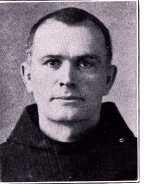
NEGenWeb Project
Church/Catholic
Franciscans
ka. After his health improved, (probably 1917-1921 or 1922), he was pastor of Baker until increasing difficulty of hearing caused his resignation. He definitely retired to the Hospital at Columbus, where he passed away in March, 1930. Some sixty priests atended (sic) the obsequies at which His Excellency, the Rt. Rev. Bishop J. F. Rummel, D. D., officiated. Rt. Rev. Msgr. F. Peitz, of West Point, delivered the funeral sermon. The remains were laid to rest in the lot of the Franciscan Fathers, whose ranks he

Rev. Maximilian Klein, O. F. M. (Deceased)
had twice made an attempt to join, his Lordship refusing permission.--R. I. P.
REV. JOHN B. FRIGGE,
OCTOBER,
1902-THE PRESENT DAY
Father Mueller was succeeded at Raeville by the Rev. John B. Frigge. Repelled by the rather primitive conditions there Father Frigge was willing to quit, but was induced to stay and neither he nor the parish has reason to regret his change of mind. Not only did the new pastor do all in his power to build up Raeville spiritually, but he has built up church, school, parochial residence and the town also materially in a wonderful way. When the Sisters of St. Joseph were recalled to serve the needs of their home diocese of Concordia, the Franciscan Sisters of Milwaukee were invited in 1907 to fill the vacancy in school. Three years later the old school was replaced by a modern brick building. The present magnificent temple of God was begun in 1917 and completed in 1919.
DEDICATION OF THE SPLENDID NEW CHURCH
On July 14, 1919, the patron feast of St. Bonaventure's, His Grace, Archbishop-Bishop Harty, D. D., dedicated the magnificent new church recently erected, one of the finest in Nebraska. Accompanied by about thirty priests, the Rt. Rev. Ordinary proceeded amid the strains of the Raeville Cornet Band from the pastoral residence to the church. The dedicatory ceremonies over, a solemn Pontificial (sic) High Mass "Coram Episeopo" was sung, in which especially former pastors or sons of the parish participated. We mention only Fathers John Mueller, Moser, Lordemann, Birnbach and Theodore Buelt. Rev. Cyriac Stempel, O. F. M., preached in German and Father Bernard Lordemann in English. In his address the Archbishop, in his inimitable way, lauded pastor and parish.
THE NEW CHURCH
The new church was designed by Mr. J. M. Nachtigall, of Omaha, and constructed by Mr. A. Kettler, of Dubuque, Iowa. The best material was used. The light colored impervious clay brick came from Brazil, Indiana. The facade or front with stone pillars and trimmings is very impressive. The roof is covered with real Ludovici tile. The exquisite painting and decorating of the interior was done by the firm Conrad Schmitt, of Milwaukee, Wisconsin. The studio of Emil Frei, of St. Louis, Missouri, furnished the stained glass windows with their wondrous color schemes. The altars, communion railing and pulpit were furnished by the Hackner Company, of La Crosse, Wisconsin. The
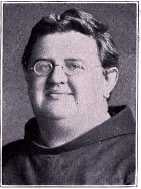
Rev. Marcelline Kollmeyer, O. F. M. (Deceased)
style of the building is the Romanesque and of the furniture, the Renaissance. The cost of the imposing structure was about $100,000. The lumber taken from the old church was used in the erection of the new imposing parochial residence.
Rev. Kaup is assistant to Rev. J. B. Frigge.
At present St. Bonaventure's parish numbers ---- families and has given three priests to the service of God, viz.: the Rev. Paul S. Moser, ordained at St. Louis, Missouri, in 1906, and now stationed at Prairie Center, Riverdale P. O., Ne-
497
![]()
braska, (Grand Island diocese); the Rev. B. Lordeman, formerly of Randolph, now of Hartington, Nebraska, and the Rev. Theodore Buelt, of Elgin.
At Raeville is also the American noviate of the Benedictine Missionary Sisters of Tutzing, Bavaria, Germany, who under Archbishop Harty labored in the Philippines. His Grace requested Fr. Frigge to turn over the Raeville schools to them in 1923. In 1924 these Sisters took over the hospital at Lynch. In the same year the Raeville convent was made a priory and four young ladies arrived from Germany to make their noviate here. Miss Veronica Leik of St. Bernard was the first American novice. The Sisters do school work in this country and mis-
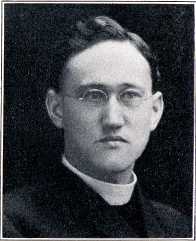
Rev. Paul Moser, Eddyville, Nebraska
sionary work in Africa, South America and Asia (China). They wear a red cingulum as a sign that they must be ready even life itself for religion. Some of their number suffered martyrdom in the Herrero rebellion in Southwest Africa.
ST. EDWARD'S CHURCH
AT
ST. EDWARD, BOONE COUNTY, NEBRASKA,
1884-1892
The settlement near the present St. Edward was formerly known as Watertown. The name St. Edward, so we are told, was given by some of the early non-Catholic settlers coming from the vicinity of South Bend, Indiana, in honor of the famous founder of the Notre Dame University, Rev. Edward Sorin. The first Mass was said at the home of Patrick Coyle. In the baptismal record of St. Edward's church Father Anastase Czech, O. F. M., tells of the erection of the first church as follows:
"In the fall of 1884 I planned to erect a Catholic church in Genoa. For this purpose I drove around visiting the Catholics of the vicinity. Most of the money was signed by the Catholics of Lookingglass. But when it came to paying, some of the subscribers did not pay. The land for the church was obtained from the St. Edward Land and Immigration Company. The site is described as follows:
"Beginning at a point 82 1/2 feet north of the northwest corner of block 47 in the St. Edward Land and Immigration Company's Third Addition to the town of St. Edward, east 132 feet, thence south 132 feet, thence west to the beginning 132 feet, said tract to be for a church, school and pastoral residence.
"Also three acres of ground off the west side of a 10 acre tract in the northeast corner of the east half of the northeast quarter of section one, township 18, North Range West to be used for a cemetery. Also in fee simple lots 7 and 8 in said block 47 in the St. Edward's Land and Immigration Company's Third Addition to the town of St. Edward, thence west 132 feet, thence north 132 feet, thence east 132 feet, thence south to the beginning. The deed for the land is at the Bishop's. Lots 5 and 6 in block 31 in the unrecorded plat of the town of St. Edward.
CONTRIBUTIONS FOR ST. EDWARD'S CHURCH
The following Catholics subscribed but not all paid:
| Bruder Bros. | $10.00 |
| Theodore Steinbach | 8.00 |
| John Zimmermann | 25.00 |
| French Vincent | 25.00 |
| Pat Coyle | 30.00 |
| George Hau | 40.00 |
| A. Smith | 50.00 |
| Cornelius Koch | 40.00 |
| W. Frost | 40.00 |
| Heinrich Werner | 25.00 |
| Frank and Nick Koch | 40.00 |
| Frank Kiernan | 30.00 |
| Jeremiah Flaherty | 25.00 |
| John Ryan | 5.00 |
| John Smers (Genoa) | 13.00 |
| Will Corcoran | 22.50 |
| John Matthews | 5.00 |
The business people contributed $151.50. In all $530 in cash were received and deposited in the bank until a sufficient sum was on hand.
Finally work was begun. As Father Anastase was too busy, he requested Fr. Boniface Depmann, O. F. M., pastor of St. Joseph's at Platte Center and St. Michael's at Albion, to look after the building. Fr. Boniface himself unloaded the stones. But he was suddenly celled to labor at Quincy, Illinois. The foundation for the church was laid on November 17, 1886.
498
![]()
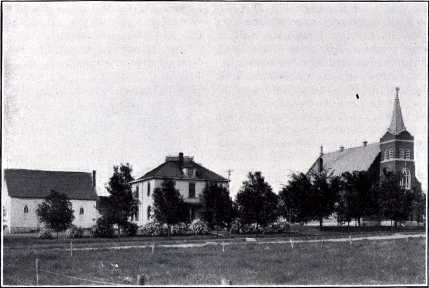
St. Edward's First Church; Pastor's Residence and New Church
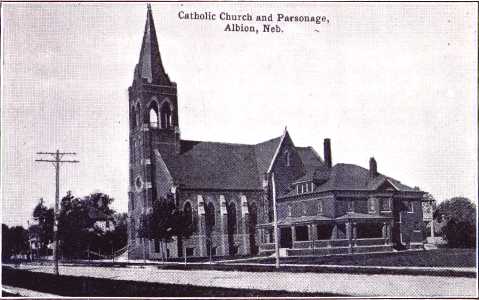
St. Michael's Church and Pastoral Residence, Albion
499
![]()
The collection on this occasion amounted to $45.15. As Fr. Anastase could not be present very much, work progressed slowly. Messrs. Cornelius Koch and Pat Coyle, however, deserve much credit for pushing the building to conclusion, as is universally acknowledged. On April 1, 1888, Fr. Anastase blessed the building privately and read the First Mass in the same. After it was plastered and the priest's room arranged, the expenditure up to December, 1888, amounted to $1,500.00; the indebtedness to $42.00.
On April 1, 1888, the first parish meeting was held. It was unanimously resolved that each family annually contribute $10.00 to the pastor's salary.
WHY FR. ANASTASE REFUSED TO SELL THE CEMETERY
"The St. Edward's Loan and Immigration Company had donated to us four lots in block 31 and three acres of land for a cemetery. In 1888 the Protestants begged me to transfer to them the three acres which lie west of their seven acres of cemetery land. They would purchase another piece of land for us. I refused to enter upon their plan for the following reasons:
"1.--The site they offered to us was low and the roads leading thither bad.
"2.--Our three acres are too fine.
"3.--The Protestants merely wanted to make money on our three acres by selling lots at fabulous prices."
The first baptism recorded at St. Edward's (earlier baptisms as those of Albion, are recorded since 1877 at Platte Center), was that of Isabella Vincent, daughter of Delphis and Theresa Vincent, born June 6, 1887, and baptized June 14, 1887, by Rev. Anastase Czech, O. F. M. The sponsors were: Pat Coyle and Marie Case. Other baptisms since February, 1889, were those of Mary Susan Hau, Michael O'Brien, Catherine Regina Cunningham, M. Matilde Zimmermann, Marie Abie Wright, 21 years of age; W. Patricia Coyle, John and Loretta Case, Sara Frances Ponderen, Loretta Cahill, Joseph Vincent, Walter Fox, Joseph Koch, Margaret Flaherty and Edward Werner.
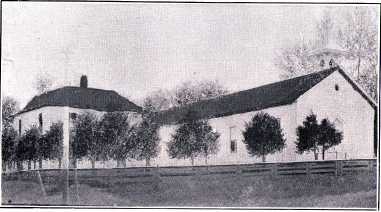
Old St. Michael's Church, Albion, Boone County
Other priests who attended St. Edward's were: Rev. Godfrey Hoelters, O. F. M., in 1889; Rev. Ladislaus Czech, O. F. M., and since August, 1892, Rev. John Mueller, first resident pastor at Raeville.
The first death recorded at St. Edward's is that of Eugene Flaherty, who died December 18, 188-? (the rest is torn out).
In due time St. Edward, too, received its resident pastor. The present rector is the Rev. W. Mulligan. A fine church and pastoral residence now rise beside the old frame church, remodelled (sic) into a community hall by the pastor.
ST. JOHN'S CHURCH--
PETERSBURG, BOONE COUNTY
The Catholics of Petersburg originally, about 1888-1896, belonged to the Raeville parish. As their number increased, Rev. John Mueller purchased the old Methodist Episcopal church and remodelled (sic) it. It was dedicated to St. John the Baptist. Rev. Birnbach, assistant to Rev. Mueller, took charge. The first resident pastor of the Petersburg Catholic parish was the Rev. M. Einzig, 1898-1899. He was succeeded by the Rev. John W. Jungels, 1899-1917. During his administration the church was enlarged at a cost of $5,554. The fine brick school and Sisters' residence (the latter on the third floor) was erected at a cost of $43,000. His successor, the Rev. B. Teves, erected in 1919, the splendid parochial residence at a cost of about $26,000. The grade school is taught by four Franciscan Sisters of Milwaukee and is attended by 168 pupils. The high school has one teacher and nine pupils.
Rev. Teves was transferred to Randolph a few
500
![]()
months ago (in 1930). His successor at Petersburg is the Rev. Francis O. Schopp.
He built a fine church at Ohleyen about two or three years ago and, let us
hope, will give the Petersburg people what is badly needed--a fine, commodious
new church.
The Christian Mothers' Society is the only society existing at present in the parish.
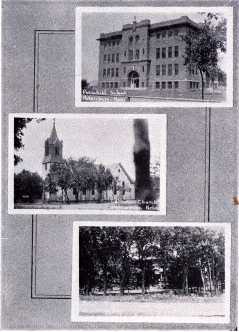
St. John's Parish Buildings, Petersburg, Boone County
Ewing, Holt County
Under date of August 21, 1884, Fr. Anastase writes as follows:
"Very Rev. R. A. Schraffel, Vic. Gen.
"Very Rev. Father:
"In Holt county, near Ewing Station, there are many Polanders, and they asked me now for the second time to visit them and give them a chance to go to confession, which they had no opportunity to do since they are there (that is, for 3 or 4 years). Not knowing to which district they belong and knowing that the Rt. Rev. Bishop is not at home, I leave it to you, if you think it advisable, to allow or authorize me to visit these people.
"I remain very respectfully
"Yours,
"P. Anastase Czech, O. S. Fr."
For Historical Sketch of Elgin see page 559.
Another letter Fr. Anastase wrote gives more detailed information:
"Columbus, Nebr., Dec. 20, 1884.
"Last month, being in Holt county, south of station Ewing, I held two meetings in two different places. The number of families will be 70 or 80. Almost each family had some of its members at the meeting. Telling them first, that you would prefer to see the church built near a railroad station and explaining the reasons you have in thinking so, all agreed unanimously to have the church built in Ewing, and then, because the farmers of Frenchtown wish to join, too. One of these Frenchtown families being in the meeting, assured us of the willingness of his countrymen in joining the congregation. The same was told to me by many Germans as well as Polanders, who talked with those people when in town. I abstained from going myself to Frenchtown and holding a meeting there, thinking not having the right to do it without your special permission. But should you like the plan of having Frenchtown together with Ewing, it would be very advisable, if you would send word to the priest who occasionally visits them, that he may exhort the people to contribute liberally towards the erection of the new church. Should there be no priest, who has special charge of these people, I, myself, would willingly do it at my next visit, but only after having obtained your special permission. I could see that the people are in earnest, and I hope they will be able to support a priest, too. An Irish Catholic living at Ewing already has donated three acres of land within the town limits.
"The farmers living south of Ewing, though still beginners and mostly very poor, raised a subscription of $725. From the business men of Ewing we expect at least $200; Frenchtown may raise about $1,000 for the farmers there are in good circumstances, together with the permission of beginning next spring with the building. "I remain yours,
"Most obedient servant in Christ,
"P. Anastase Czech, O. S. Fr."
501
![]()
St. Boniface Church, A. D., 1912 |
|
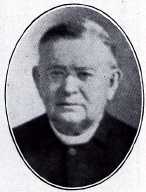
Rev. Casirnir Renner |
|
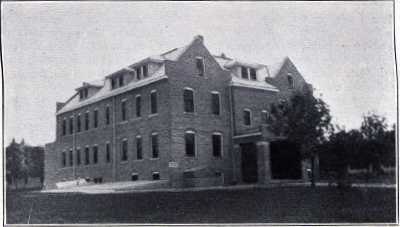
St. Boniface School, Elgin, Nebraska |
|
502
![]()
|
|||